Pakistan Naval Air Arm
| Pakistan Naval Air Arm | |
|---|---|
|
Command Naval Aviation logo, COMNAV | |
| Active | 1971 – Present |
| Country |
|
| Branch |
|
| Type | Naval aviation |
| Size | 60 aircraft, 28 helicopters |
| Part of | Pakistan Navy |
| Naval Air Headquarters | Mehran Naval Air Base, Sindh Province, Pakistan |
| Nickname(s) | Pakistan Naval Aviation |
| Motto(s) | Resources are limited; creativity is unlimited |
| Colors | Navy blue and White |
| Engagements |
1999 Atlantique Incident 2001 Indo-Pakistan standoff War on Terror Combined Task Force 150 |
| Commanders | |
| Commander Naval Air Arm, COMNAV | Rear Admiral Zain Zulfiqar |
| Insignia | |
| Roundel |
 |
| Aircraft flown | |
| Attack | Westland Lynx, Dassault Mirage V (Operated by PAF) |
| Electronic warfare | Raytheon Hawker 800 |
| Helicopter | Aérospatiale SA-319B Alouette III, Aérospatiale Alouette II, Harbin Z-9 |
| Patrol | Lockheed P-3C Orion, Fokker F27-2000, Breguet Atlantique, Britten-Norman Defender |
| Reconnaissance | SATUMA Mukhbar (UAV) |
| Transport | Westland Sea King |
The Pakistan Naval Air Arm (unofficially Pakistan Naval Aviation) is the naval aviation and naval warfare service branch of the Pakistan Navy.
The Naval Air Arm is tasked to carry out air surveillance, limited aerial warfare, and reconnaissance operations. The Naval Air Arm was created after the Indo-Pakistani War of 1971 and it is designed to operate in all facets of naval operations ranging from surveillance, tracking and subsequent destruction of enemy units.[1] The arm also takes part in operations other than war such as search and rescue, casualty evacuation, relief operations.[2][3] Early in its inception the Naval Air Arm was dependent upon the Air Force and the Army to meet its training requirement of air and ground crew.[4]
History
After the 1965 Indo-Pakistan war, the Navy attempted to established the naval air branch to sustain the purely defence naval strategy of Pakistan.[5] Chief of Naval Staff Muzaffar Hassan made an unsuccessful attempt to establish the air wing in the Navy, but this was impossible to achieve.[5] The lack of funds and the PAF itself objected the plans.[5] The air force objected any attempts as the air force saw the potential risked of losing aircraft in open-sea operations, therefore Lieutenant-General Abdul Rahim Khan, chief of air staff, remains positively hostile towards the creation of the naval air arm.[5]
Formation
The Naval Air Arm was created after the careful analysis of Operation Trident during the Indo-Pakistani War of 1971. It was established that lack of early warning from seaward, for example the absence of a naval air surveillance capability, had allowed the Indian Navy to close Karachi harbour for attacks. After studying various available options, the French Breguet Atlantique was selected and acquisition formalities were completed in 1974. Finally the first squadron was raised in 1976, with three Atlantiques.
Naval Air Squadrons
On 28 September 1974, the first of the six Westland Sea King helicopters was also acquired from the United Kingdom, marking the introduction of naval aviation and rotary wing aircraft in the service. 111 Squadron was established for these rotary wing aircraft.
To support the Naval Air Fleet, the naval base, P.N.S. Mehran was commissioned on 26 September 1975 as Naval aviation's headquarters. The base is approximately 10 kilometres (6.2 mi) from Jinnah Terminal. Sea King helicopters were the first machines to fly from this base. Atlantique and Aérospatiale Alouette III helicopters soon joined the Naval Air Arm. As the formation year of 1976 coincided with 29th year of Pakistani independence, the first squadron of Atlantiques was named 29 ASW Squadron. In 1977, six Alouette helicopters were acquired from France leading to the formation of 333 Squadron. In 1982 Fokker F-27 Aircraft were acquired, leading to the formation of 27 Squadron.
In early 1994, three Lynx helicopters were acquired from the United Kingdom leading to the formation of 222 Squadron. In 1996, three P-3C Orion aircraft were acquired from United States and were inducted into 28 Squadron of the Naval Air Arm. The delivery of these long range maritime patrol aircraft had earlier been withheld due to the application of the Pressler Amendment in 1990. One of these planes was lost due to an accident while carrying out routine exercises in own coastal waters on 29 October 1999.
Atlantique Incident

The Atlantique Incident was a major international incident that occurred on 10 August 1999 when a Pakistan Naval Air Arm patrol aircraft—a Breguet Atlantique with 16 personnel on board—was shot down in the border area of the Kutch region by Indian Air Force jets. Pakistan and India both claimed the aircraft to be in their respective airspace.
Some experts stated that the Atlantique was probably conducting a "probe" on India's air defence system, mainly the radar equipment in the border area; however, they advised that it was not part of any planned aggressive military action by Pakistan.[6] Foreign diplomats who visited the crash site noted that the plane "may have strayed into restricted space", and that Islamabad was unable to explain why it was flying so close to the border; they however added that India's reaction to the incident was not justified.[7] Many countries, the G8, the permanent members of the UN Security Council, as well as the western media questioned the wisdom behind Pakistan's decision to fly military aircraft so close to the Indian border.[8]
On 21 September 1999, Pakistan lodged a compensation claim at the International Court of Justice (ICJ) in The Hague, accusing India of shooting down an unarmed aircraft. Pakistan sought about US$60 million in reparations from India and compensation for the victims' families. India's attorney general, Soli Sorabjee, argued that the court did not have jurisdiction,[9] citing an exemption it filed in 1974 to exclude disputes between India and other Commonwealth States, and disputes covered by multi-lateral treaties.
On 21 June 2000, the 16-judge Bench headed by Gilbert Guillaume of France ruled—with a 14–2 verdict—upholding India's submission that the court had no jurisdiction in this matter.[10][11] Pakistan's claims were dropped, without recourse to appeal, and the outcome was seen as a decision highly favourable to India.[12][13] The Pakistan government had spent close to 25 million Pakistani rupees (approx. $400,000) on the case.[14]
Tehreek-i-Taliban attack
On 22 May 2011, Tehreek-i-Taliban attacked the PNS Mehran naval base and destroyed P-3C Orion aircraft.[15]
Naval Air Bases
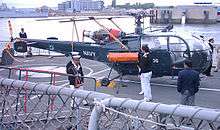
- P.N.S. Mehran at Karachi
- P.N.S. Makran at Pasni
- P.N.S. Siddique at Turbat[16]
Aircraft inventory
| Aircraft | Operational | Role | Quantity | Notes |
|---|---|---|---|---|
P-3C Orion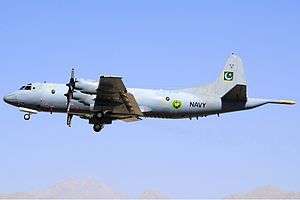 |
1996 | MPA | 7 | Three P-3C Update II.5 aircraft were ordered in 1988 and delivered between 1996 and 1997; one was lost in a crash in October 1999. Seven second-hand P-3C rebuilt to P-3CUP standard were ordered in 2005-2006 and delivered between 2007 and 2012.[17] A 2011 attack at Mehran Naval Airbase destroyed two P-3CUP Orion aircraft after which the United States agreed to replace them at a later date.[18] |
Westland Sea King 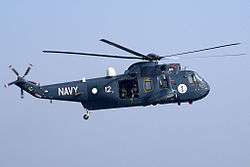 |
1974 | ASW, ASuW, SAR | 6 | [19][20] |
| Fokker F27 |
1982 | ASW/Transport | 5 | Seven acquired in 1980s,five for Navy and two for air force[21][22] |
Hawker 800 |
1985 | Electronic warfare | 4 | 4 delivered as of 2014. |
Aérospatiale Alouette III SA-319B  |
1977 | Training, SAR, Reconnaissance. | 10[23] | 10 delivered as of 2013. |
Harbin Z-9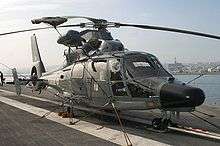 |
2009 | anti-submarine warfare | 12 | 12 in service as of 2011. |
| ATR72-212A |
2013 | Transport Aircraft + MPA | 3[24] | Received August 2013. One more additional received in August 2016.[25][26][27] |
Unmanned Aerial Vehicles (UAV)
| UAV | Operational | Role | Quantity | Notes |
|---|---|---|---|---|
| UQAB-II |
2010 | Reconnaissance | 20 | UQAB-II has a range of 100 km and endurance of more than 6 hours. The aircraft can carry a 20 kg payload consisting of a gyro-stabilized Gimbal with color day camera, and a thermal imager with target tracking and locking capabilities which can transmit real time video to the aircraft's ground control station (GCS). The UQAB's GCS is a truck mounted air-conditioned, insulated container equipped with ruggedized consoles.[28] First squadron inducted in July 2011.[29] |
| LUNA |
2010 | ECM/ECCM | 08 | Contract signed in 2012.[30] |
| ScanEagle | 2016 | Reconnaissance | unknown | Inducted in 2016 |
Retired aircraft
| Squadron | Operational | Aircraft | Role | Comments |
|---|---|---|---|---|
| 16 Squadron | 1980-1981 | Grumman Albatross  |
SAR | Four transferred to Navy from Air Force for SAR were probably retired in 1981.[31] |
| 29 Squadron | 1976-2012 | Breguet Atlantique |
ASW | Six acquired by Navy for Anti Submarine Warfare.Last remaining Atlantique retired on September 5, 2012.[32] |
| 222 Squadron Stingrays | 1982-2012 | Westland Lynx 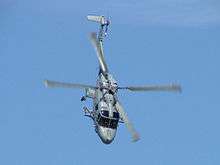 |
Surveillance/ASW/SAR | Three helis grounded as of 2012.[33] |
See also
| Wikimedia Commons has media related to Aircraft of the Pakistan Navy. |
Pakistan Navy Pakistan Air Force
Notes
- ↑ http://www.paknavy.gov.pk/helicopter.htm
- ↑ http://www.paknavy.gov.pk/aircrafts.htm
- ↑ http://www.globalsecurity.org/military/world/pakistan/navy-intro.htm
- ↑ http://www.paknavy.gov.pk/mehran.htm
- 1 2 3 4 Goldrick, James (1997). No Easy Answers. New Delhi, India: Lancer's Publications and Distributors. pp. 63/65/66. ISBN 1-897829-02-7.
- ↑ http://www.globalpolicy.org/component/content/article/187/34571.html
- ↑ http://news.bbc.co.uk/2/hi/south_asia/419325.stm
- ↑ http://defencejournal.com/sept99/post-kargil.htm
- ↑ http://www.tribuneindia.com/2000/20000404/world.htm#4
- ↑ http://www.icj-cij.org/docket/index.php?sum=585&code=pi&p1=3&p2=3&case=119&k=b5&p3=5
- ↑ http://www.icj-cij.org/docket/files/119/8088.pdf
- ↑ http://www.tribuneindia.com/2000/20000622/main3.htm
- ↑ http://news.bbc.co.uk/2/hi/south_asia/800433.stm
- ↑ http://www.dawn.com/news/48242/govt-comments-sought-in-atlantique-case
- ↑ Taliban destroy two Pakistan navy P-3Cs
- ↑ "Recent Naval Developments". http://pakakhbar.com/military/navy.html. External link in
|website=(help); - ↑ "Pakistan navy planes to get more teeth". expressindia.indianexpress.com. 14 February 2007. Retrieved 28 March 2014.
- ↑ "US to replace two P3C Orion aircraft". Dawn. 17 June 2011. Retrieved 28 March 2014.
- ↑ Lake, Jon. "Westland Sea King: Variant Briefing". World Air Power Journal. Page 130, Volume 25 Summer 1996. London:Aerospace Publishing. ISBN 978-1-874023-79-1. ISSN 0959-7050. pp. 110–135.
- ↑ http://www.naval-technology.com/projects/seaking/
- ↑ "Pakistan to receive US surveillance P3C Orion this year". Global Times. 28 January 2013. Retrieved 9 September 2013.
- ↑ "Pakistan to get US surveillance plane this year". Daily News (New York). 28 January 2013. Retrieved 9 September 2013.
- ↑ "Naval Recent Developments". http://www.pakakhbar.com/military/navy.html. External link in
|website=(help); - ↑ "Recent Naval Developments". http://pakakhbar.com/military/navy.html. External link in
|website=(help); - ↑ "Navy gets two ATR 72 aircraft". Dawn. 16 August 2013. Retrieved 16 August 2013.
- ↑ "Navy ready to counter all threats: naval chief". Daily Times (Pakistan). 16 August 2013. Retrieved 16 August 2013.
- ↑ "Two ATR-72 aircraft inducted in PN fleet". Business Recorder. 15 August 2013. Retrieved 16 August 2013.
- ↑ "UQAB-II".
- ↑ Siddiqui, Salman (July 20, 2011). "Navy inducts first fleet of reconnaissance drones". The Express Tribune. Retrieved April 14, 2013.
- ↑ http://www.suasnews.com/2012/06/17197/luna-uas-for-pakistan-navy/
- ↑ http://www.flightglobal.com/pdfarchive/view/1981/1981%20-%202536.html
- ↑ http://www.historyofpia.com/forums/viewtopic.php?f=1&t=20716&sid=f48346714fea22168c81acd2205836fc
- ↑ http://www.historyofpia.com/board/october_12/lynx_oct31.jpg
